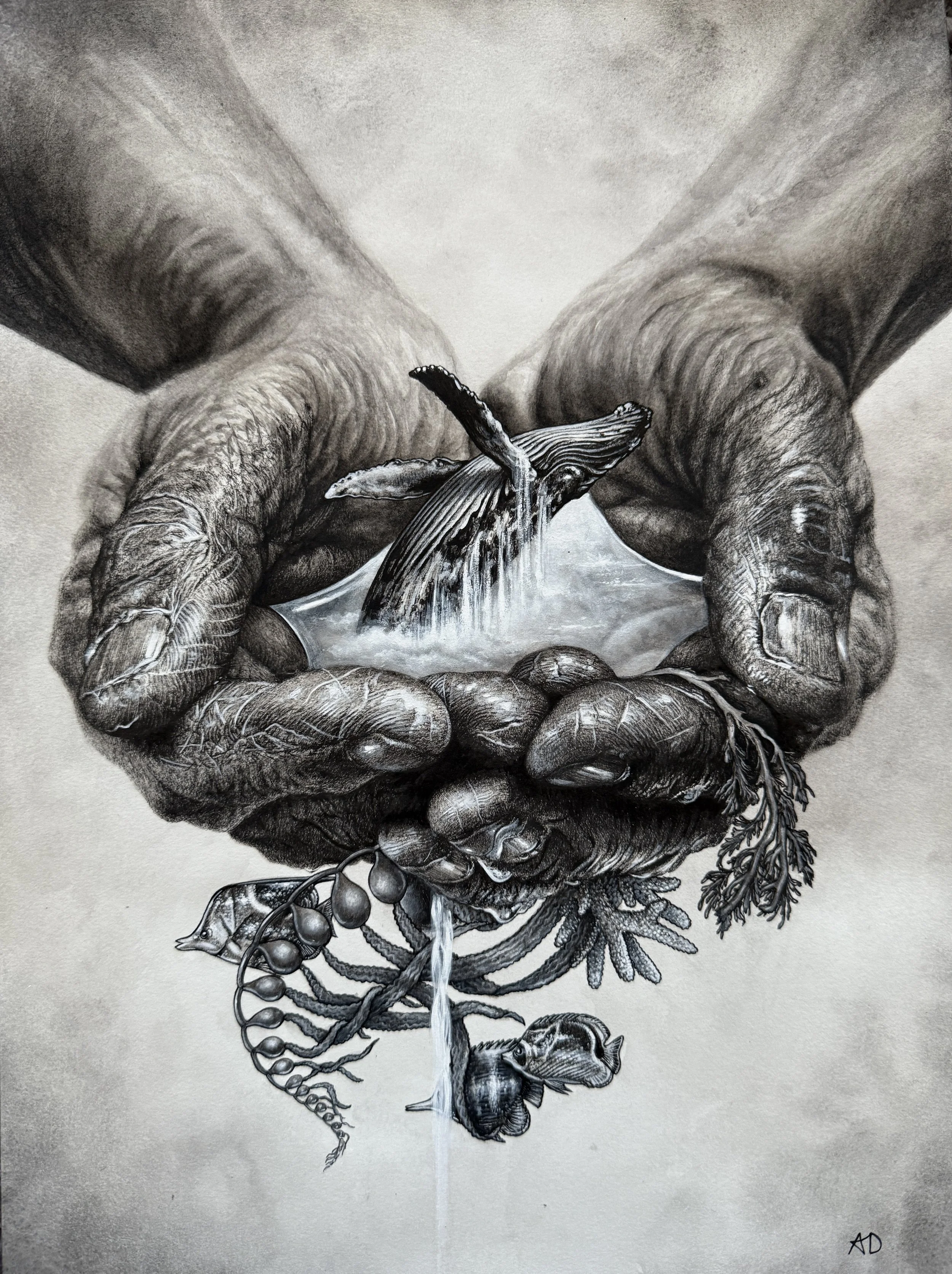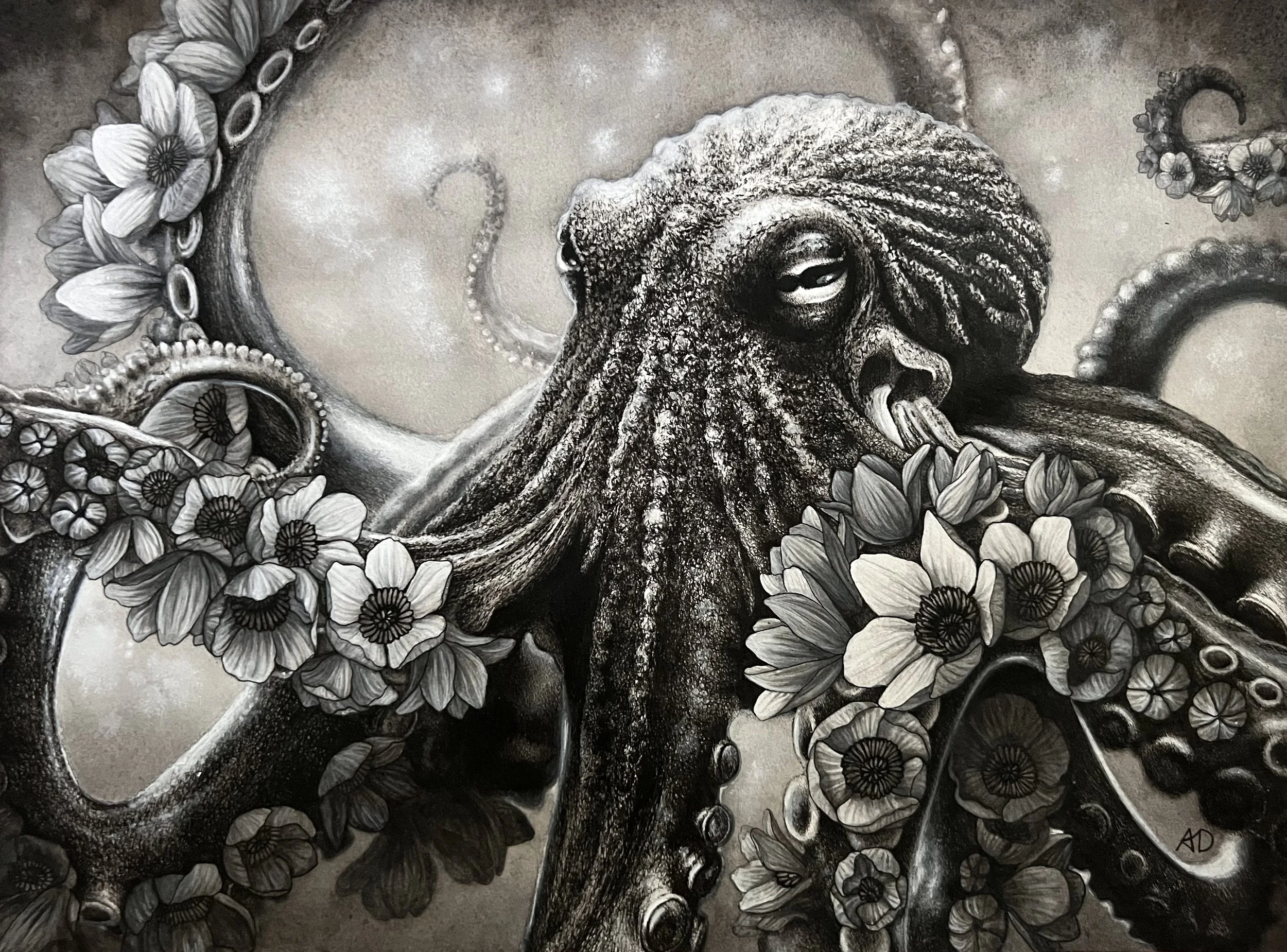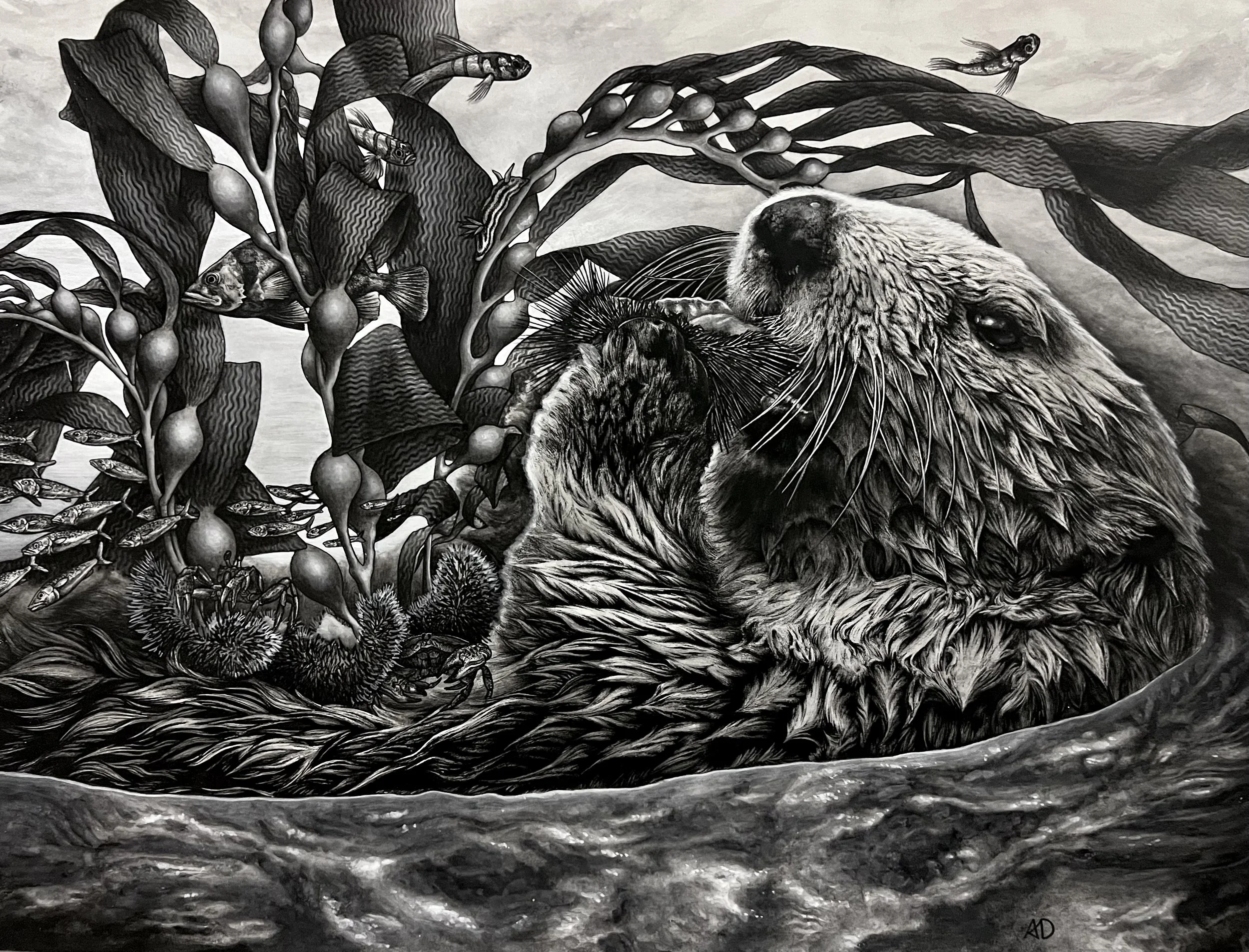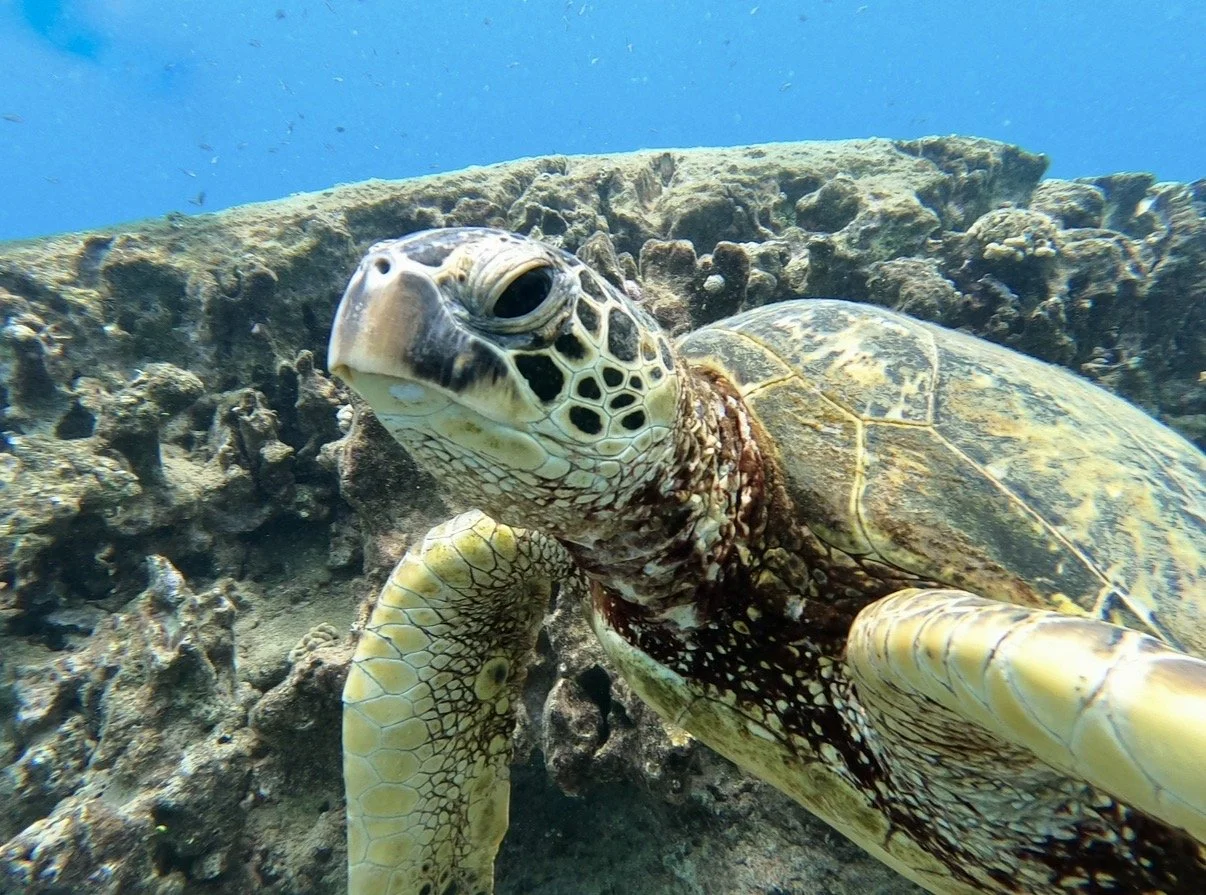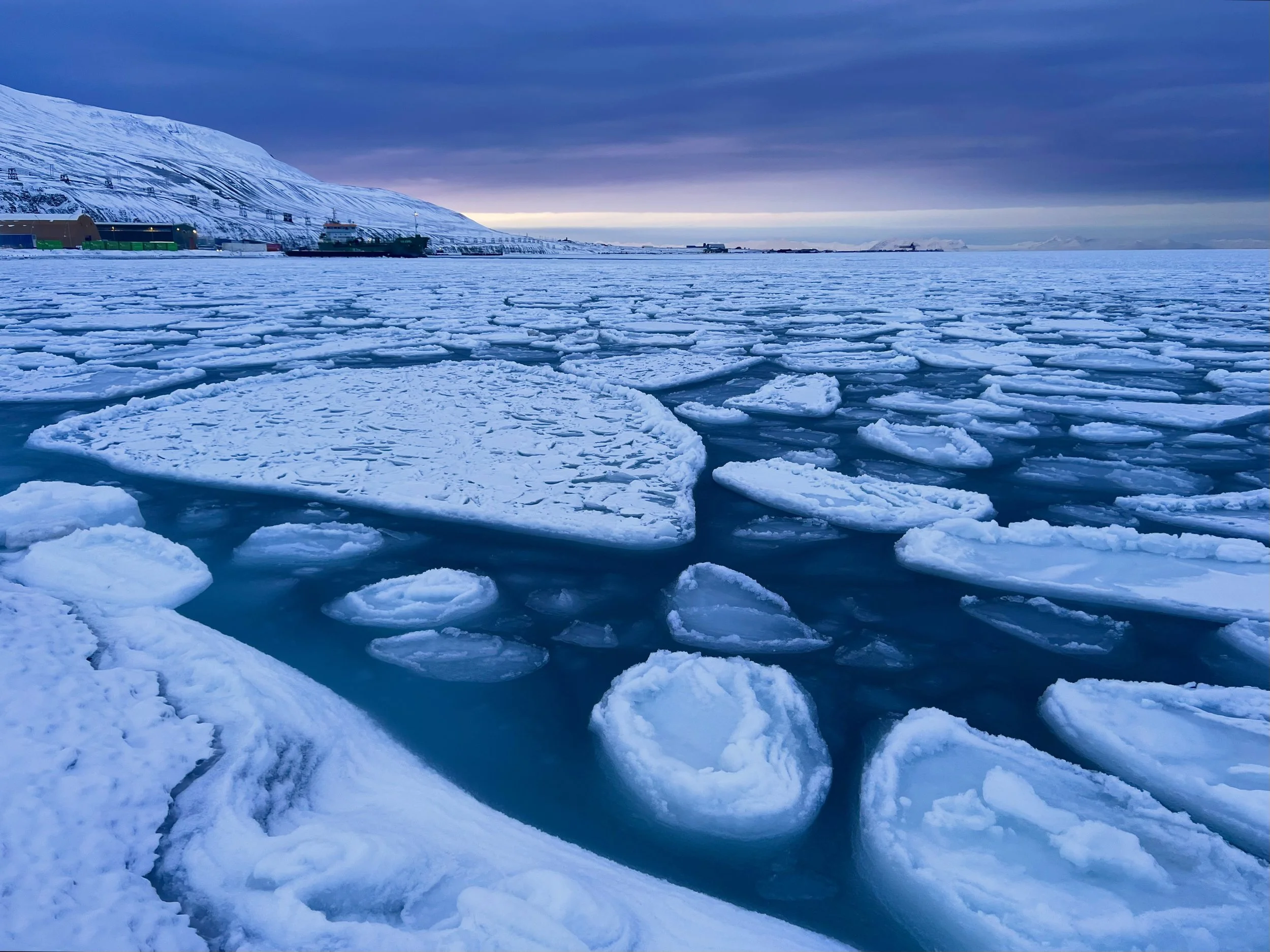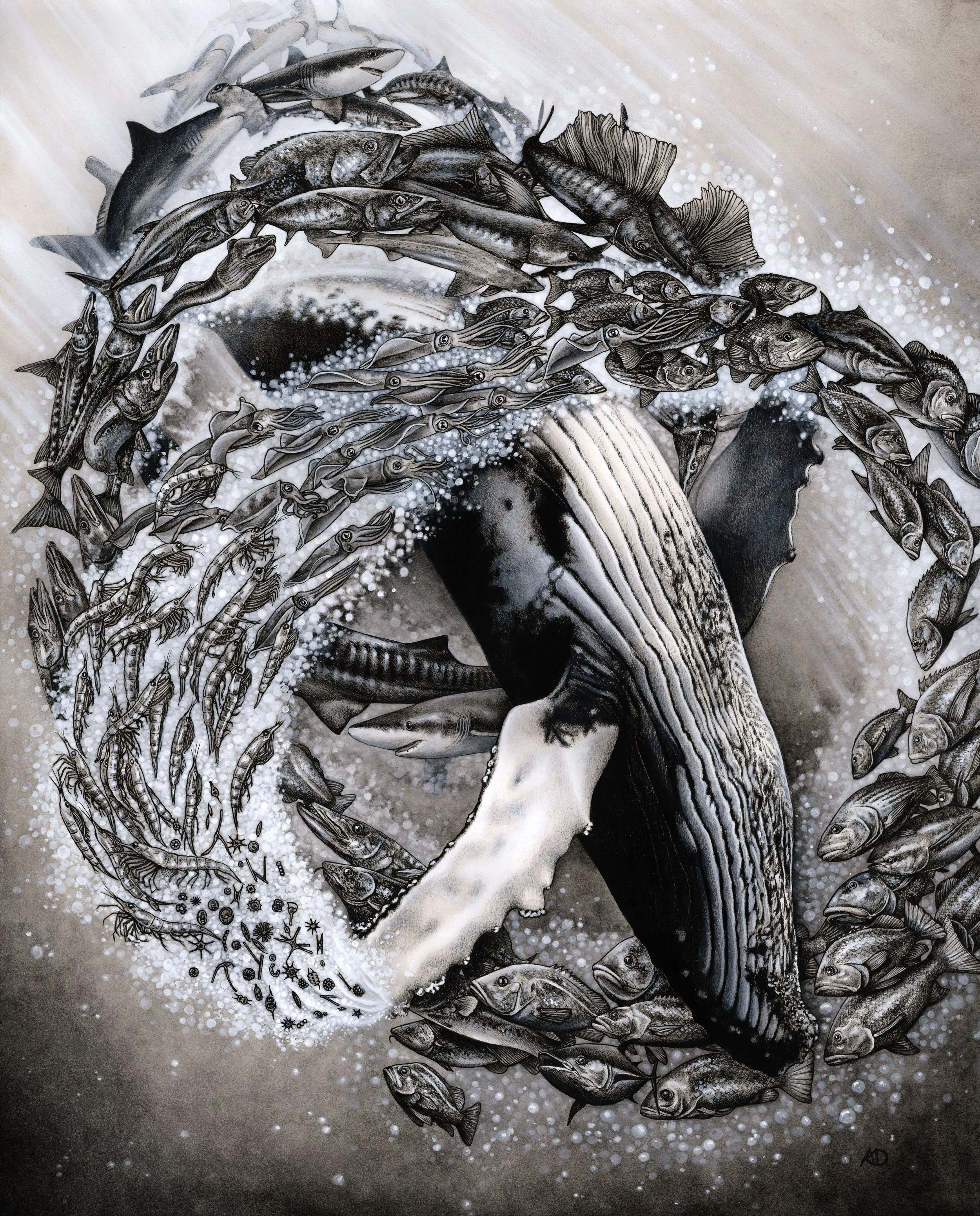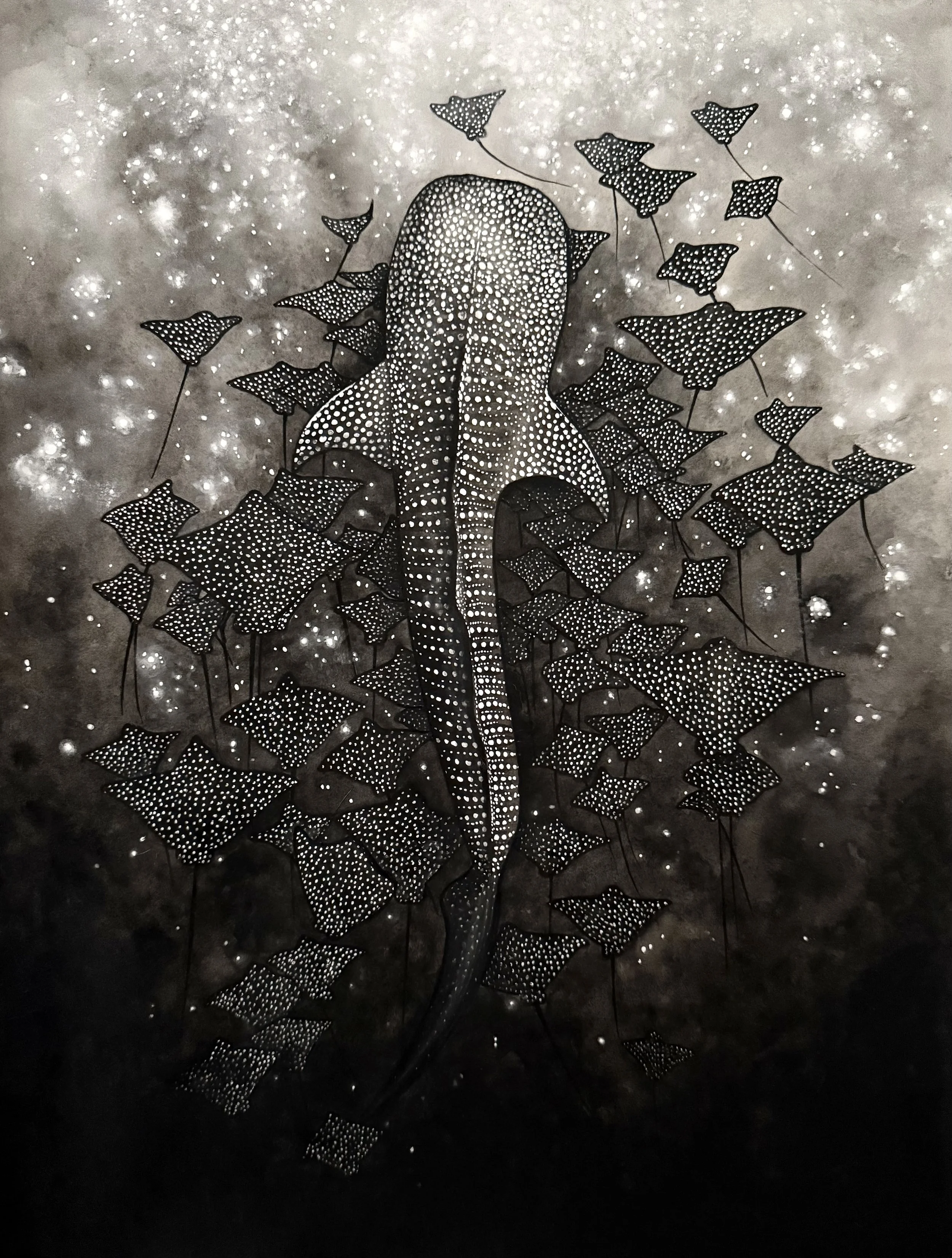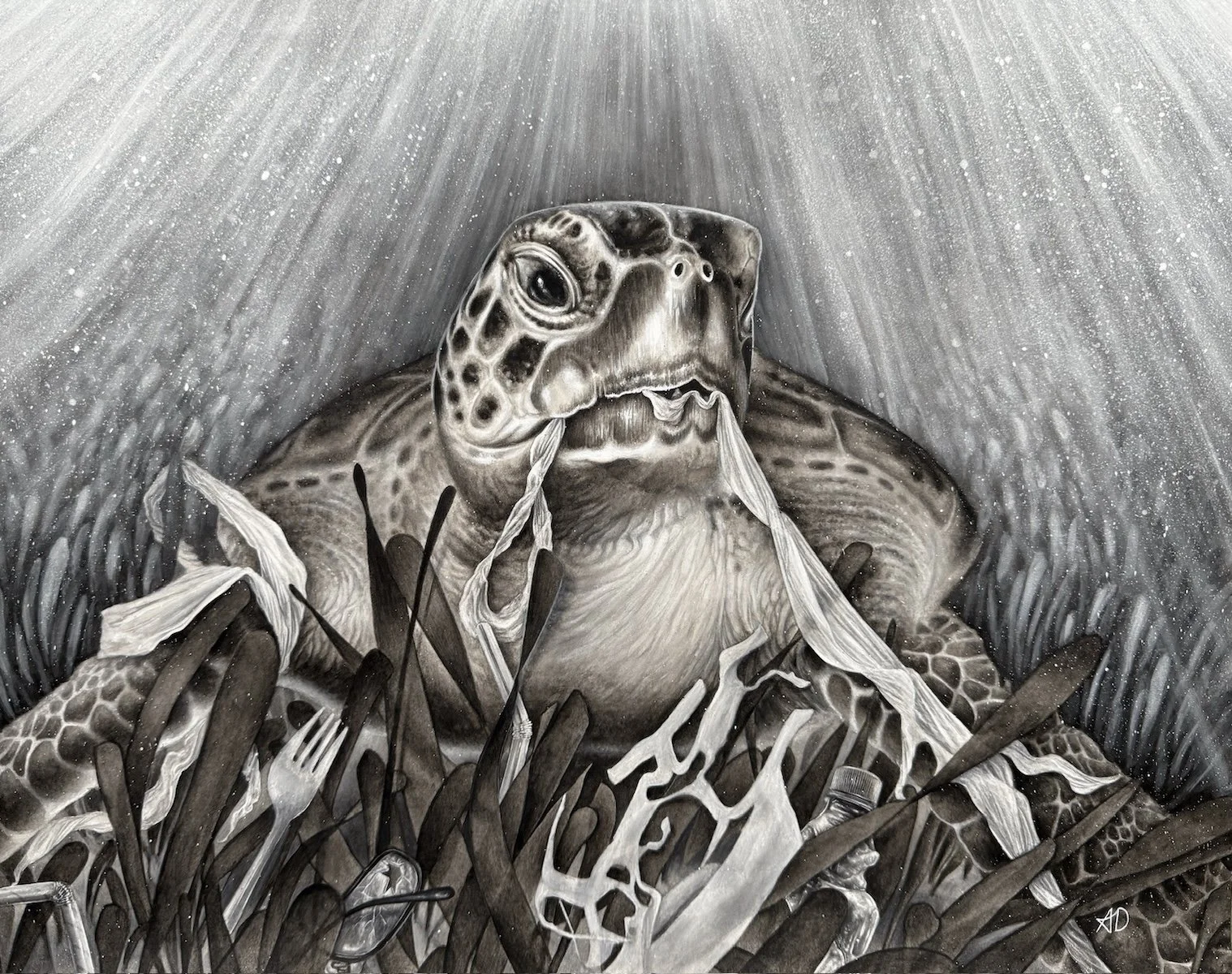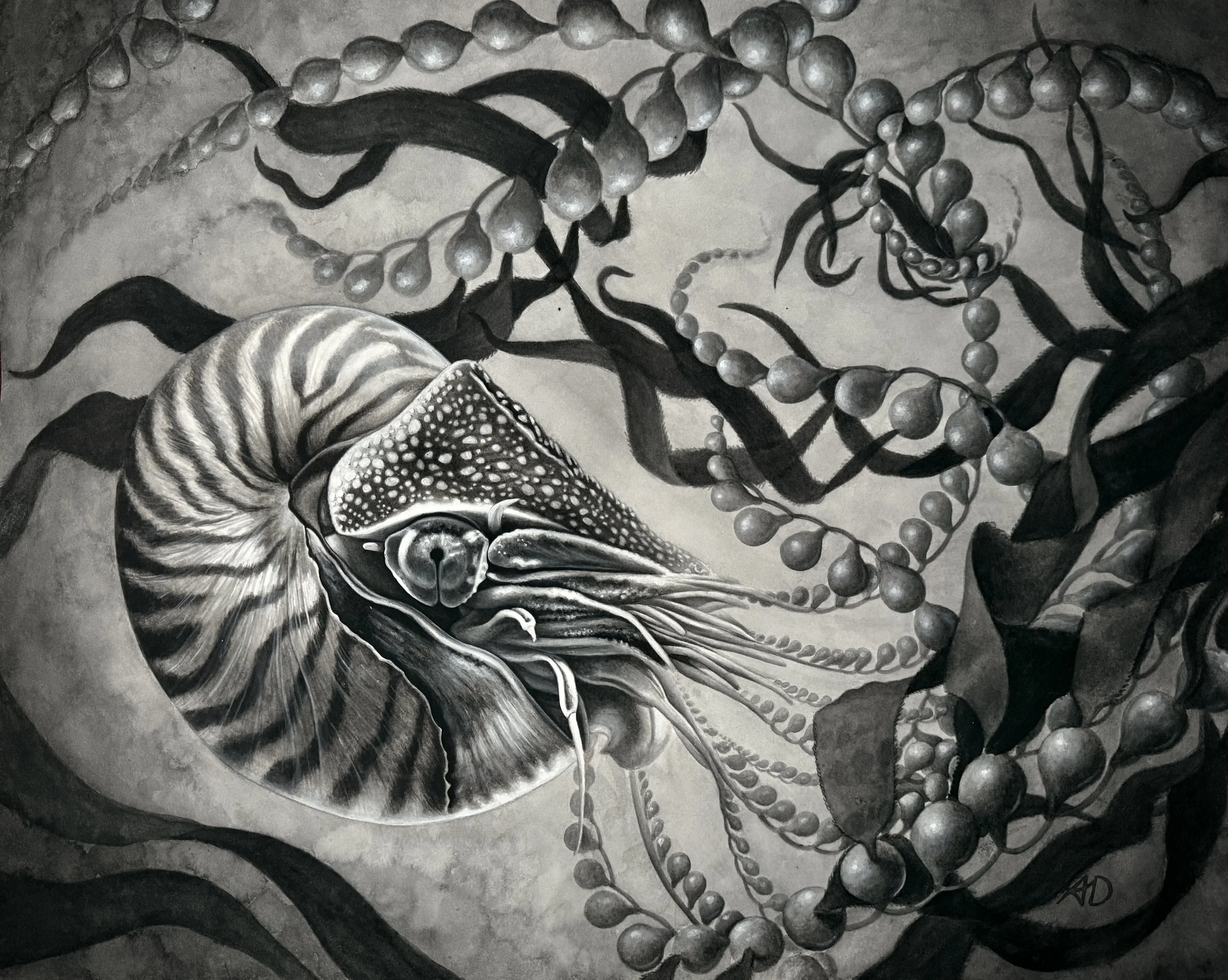Ocean
I grew up just a few miles from the Pacific Ocean and have spent many happy hours snorkeling, diving, sailing, and that thing where you miscalculate a wave and feel like you’ve been thrown in a washing machine. Ah, sea salt burn in the sinuses- the ocean’s tender kiss.
Did you know you can easily fit all of earths land masses in the Pacific’s surface area? Covering just over 30% of the earths surface, the Pacific is the largest of the oceans- and with a maximum depth of 11,000 meters at the Mariana Trench, it’s also the deepest! Named by explorer Ferdinand Magellan, “pacific” means peaceful. Magellan’s impression of the Pacific was a calm and placid one (that dude clearly has never been washing machined by a giant wave). It’s a bit ironic really, seeing as the Pacific Ocean is often referred to as the "Ring of Fire" due to the intense tectonic activity that takes place in it. The Ring of Fire is responsible for ~90% of all earthquakes, and in home to 75% of Earth's volcanoes. I guess it’s more “piece-ful”… because of the tectonic plates… anyway moving on. The awesome thing about the size of the Pacific Ocean is its vast biodiversity- most of which we don’t have a clue about! As recently as May 2023, a study was published cataloging ~5,000 new species! And people say the age of exploration is over… yeah, right. The biodiversity of the Pacific is so extreme because the area it covers is so immense- from the freezing northern waters to the warm Hawaiian atolls, the temperatures vary nearly as much as the marine life.
There has never been a more urgent need to protect and conserve our oceans. As the largest and most important earth system, it’s astonishing that only 5% has been explored, especially while we spend billions on space exploration. But as has been proven time and time again, people tend to care about what they can see, understand, and connect with. Most people know of the ocean as waves and horizons- only what’s on top. It’s hard for them to grasp the danger the ocean is in when acidification, fishery depletion, coral bleaching, and so many other threats don’t change what the surface looks like. The vast abundance of life below is virtually unknown and unseen by the majority of the population.
The ocean covers 71% of our planet and is a driving force of the health and livability of the earth. Ocean dynamics, CO2 absorption, heat regulation, and so much more are the gears that keep our home running. The deep depths hold untold medicines and cures, the kelp forests present plastic alternatives, reef ecosystems hold secrets of symbiosis and interconnectedness. And yet, ocean science is inordinately underfunded and disregarded. It’s a constant shock to me when I bring up an ocean or sea life fact, or an abhorrent practice like shark finning, and most people have never even heard of it. Not that everyone need be as huge an ocean and natural science nerd as I am, but it’s truly astonishing that this environment that makes up the vast majority of the earth is just… ignored. And with the effects of climate change not only looming but currently ongoing, it’s frightening.
While participating in an artist residency on Svalbard, I got to witness firsthand the changes in sea ice and the struggle of arctic marine animals. During the months of polar night I also became hooked on ocean documentaries like Seaspiracy and Mission Blue, then read every book I could find on oceanography, marine biology, and the undiscovered deep. Documentaries and books are forms of art. When I made the connection that my passion for ocean science was sparked by art, I knew the direction I wanted to take my own work in. Art is a communication tool, and an effective one. And I am determined to use mine to fuel emotional connection, understanding, and the desire to protect our oceans.
“To look at the surface of the ocean without knowing the sparkling web of life that is woven through its depths is to be blind to its wonders and the part it plays in making our existence possible”. -Edith Widder
Humpback whales (and whales in general) are super fascinating and intelligent! They’re long lived, and can live up to 100 years (if you think that’s crazy, the Bowhead whale can live 200 years or more, and are the longest-living mammals). They can grow up to 60ft long and weigh up to 80,000 lbs (by the way, that’s nothing on the Antarctic blue whale, which can grow up to 98ft long and weigh 400,000 lbs! That’s 33 elephants!)!
Humpbacks are non-predatory filter feeders, and migrate every year to their feeding and breeding grounds with as much as 16,000 miles between the two areas. They eat only in the winter, and live off their fat reserves while migrating and breeding.
Humpbacks communicate by composing beautiful and intricate songs using moans, whistles, creaks, and more- if you’re not familiar with these haunting melodies, I highly recommend looking them up on YouTube. The songs can last up to 20 minutes, and can be heard up to 20 miles away. There are geographical dialects, repeating patterns like a billboard top 10 list, and songs with different themes and purposes.
Researchers are actually unsure how the whales produce these sounds. They don’t have vocal cords, and no air escapes their closed mouths while they sing. It’s thought that they sing by circulating air through the tubes and chambers of their respiratory system.
It’s also not known why they breach (jump out of the water). There are a few theories, such as use in communication, but my favorite theory is that they do it just for fun!
On June 11, 2024 the Icelandic government announced that it would be re-issuing a license to the whaling company Hvalur. This license allows them to kill 128 endangered fin whales in this year alone.
The primary hunting tool used for whaling is an explosive-tipped harpoon that detonates on impact. The device then releases barbed hooks used for hauling the whale on board. In a 2022 study, some whales killed via this method have taken up to two hours to die, and 41% of whales killed suffered immensely before dying after an average of 11.5 minutes.
I know this is disturbing, and I’m sorry to add darkness to your day. But this can’t go on. Whaling is an archaic and cruel practice, and wholly unnecessary. Most of the whale meat isn’t even used here in Iceland, but is shipped to Japan, who also practices whaling.
Iceland is a beautiful country, and I love living here. Which makes it so much more unfathomable that such a progressive country, known for its natural beauty, condones the slaughter of fin whales. The fin whale is a magnificent animal, a gentle giant deserving of respect and awe. Our greed and carelessness cannot be the end of these incredible creatures. This heinous practice must go extinct before the fin whale does.
I have drawn all 128 fin whales that have, and will be, slaughtered this year. In memory of their beautiful lives, cut horrifically short, and with grief and respect in each pen stroke. I mourn these animals, because they deserve at least that much.
Octopuses are some of the coolest creatures on earth! They can change color like a chameleon, squirt ink, have three hearts, and range from 2.5cm to 5 meters long… but that’s not nearly all!
People usually describe an octopus as having tentacles, but they’re actually arms. The suckers covering their arms are highly sensitive, and can taste whatever the octopus is touching. These arms basically have minds of their own, and are occupied by two-thirds of an octopus’s neurons. This means that an octopus can explore a cave with one arm while cracking open a shellfish with the other- the ultimate multitasker! But there’s still plenty of neurons to go around… they’re incredibly intelligent, and have been observed using tools and are highly capable escape artists.
They’re also camouflage artists of the highest caliber. They can change color and patterns, and some can change their skin texture to mimic kelp or reef. They also use their clever appendages to hide in brilliant ways- gathering shells around themselves as armor, or pulling two coconut halves together and hiding in the middle (both of these can be witnessed on YouTube!)
Octopuses may seem gentle, but they’re very capable predators. They typically drop down on their prey, enveloping it in their arms and shoving prey into their mouths, which is in the middle of their underside. They have sharp beaks for crushing shells, powerful jaws, and venomous saliva, allowing them to make quick work of shellfish, lobsters, fish, and even small sharks!
Trophic Cascade: Reciprocal predator-prey interactions that control and determine aspects and the survival of entire ecosystems. In top-down trophic cascades, the removal of the top predator has devastating effects on the rest of the ecosystem. Like a precarious game of jenga, except lives are on the line.
The endangered sea otter is the king of one such trophic cascade. How it’s supposed to go: kelp forests are preyed upon by sea urchins. Urchins are kept in check by sea otters. How it’s actually going: sea otters are endangered, and the urchins are running rampant. Kelp forests are decimated, essentially turning an important ecosystem into a spiny wasteland.
The health of kelp forests is vital to many, including us. Many species thrive in kelp forests, such as fish, crabs, mussels, and more. But apart from being a home, kelp forests actually play a huge role in the environmental health of our planet. CO2 levels in the atmosphere are rising and are absorbed by the ocean, making our oceans more acidic. However, healthy kelp forests have the ability to absorb billions of kilograms of carbon. In one eye-opening study, researchers found that “the difference in annual absorption of atmospheric carbon from kelp photosynthesis between a world with and a world without sea otters is somewhere between 13 and 43 billion kg of carbon”.
I think sometimes people wonder what all the fuss is about a single species going extinct. It’s just one species, right? What’s the difference? Well, in the case of sea otters, the difference is somewhere between 13 and 43 billion kg of carbon. Every form of life on this earth matters. Our natural world is a beautiful machine, more intricate and finely tuned than we could ever comprehend or replicate. Why care about wildlife? Because it’s all the same thing. It’s them, but it’s also us. It’s also you. It’s wildlife, and it’s our wild life.
Have you ever swam with sea turtles? It’s a pretty magical experience. Green sea turtles are the largest of the hard-shelled sea turtles, and can grow up to four feet long. They can also weigh up to 350 lbs, but you wouldn’t think that with the way they drift gracefully through the ocean blue.
Green sea turtles are unique in that they’re mainly herbivorous, with a diet of mostly algae and seagrass. In fact, it’s their green diet that gives their fat a greenish color, hence their namesake. However, green sea turtles will also occasionally eat jellyfish. This is becoming more common as climate change affects seagrass growth and algae blooms.
Turtles often mistake trash for food, and plastic bags look an awful lot like a jellyfish when floating underwater. Unfortunately, the bags cause problems even when not mistaken for prey- they don’t break down completely but instead photo-degrade, becoming microplastics that absorb toxins and continue to pollute the environment.
Did you know that walruses invented the ice axe? Ok not technically, but pretty close! While their signature tusks are used for defense and the shows of dominance you’d expect, they’re also used for navigating sea ice and ice floes. Digging their tusks into the ice and snow like axes or ski poles helps their cumbersome bodies move around on their frozen slip-n-slides. They also use their tusks to smash through ice and create breathing holes while swimming. A fun fact: their scientific name, odobenus rosmarus, means “tooth-walking sea horse”.
These blubbery buds can withstand temps as low as -95°F (-35°C)! Weighing up to 5,000lbs for males and 2,700 lbs for females, walruses have the correct body type for the Arctic beach. Another useful feature is that their blood vessels contract while in the icy water, protecting them from cold and turning them pale. Like an uncooked hotdog with fangs, they turn pink on land as their blood vessels dilate and allow heat the escape.
They’re so cold-resistant, they even sleep in the water! Walruses have air sacs called pharyngeal pouches on their throats that can hold up to 13 gallons of air. When in the water these sacs inflate like pillows, allowing the walrus to sleep vertically without drowning. Seems like a gamble having two long pointy things right at your throat air pillow but hey, whatever works I guess. You do you, walrus.
Walruses rely on rapidly declining sea ice. They migrate with ice floes and use sea ice as a platform for resting and diving for clams. Sea ice also provides a safe place for mothers to leave their calves while they gather food. The volume of ice in the Arctic has decreased by a third over the past twenty years, and the rate of decrease is accelerating. Climate scientists have suggested that by 2040, the arctic could experience an ice-free summer.
You know the situation isn’t great when you’re walking along a beautiful shoreline and you come across a lone crushed can, washed up and tangled in seaweed, and think “huh… that’s awesome that I haven’t seen more trash than that”.
There is no longer any place left on earth that is completely trash-free. Albatrosses traverse entire oceans to feed their chicks the bottle caps that will kill them. Whales commonly wash up with fishing nets and plastic bags in their stomachs. I once saw a seagull in San Francisco wearing a beer can like a collar.
The amount of trash we produce is a huge problem, but as individuals we can at least control whether our trash is put where it’s supposed to be. Littering seems like a small, harmless thing, but it’s not. Find a trash can. If there isn’t one, carry your trash until you find one. I also like to carry trash bags with me on hikes and walks in case I come across litter. It’s an easy thing that makes a big impact.
Nov - Feb 2023: In the fjords of Svalbard, the sea has not stilled all winter. These waters used to freeze, then they froze less, and now they don’t freeze at all. So what does it matter? Well, it does, and here are three reasons why:
1. Sea ice acts as a “blanket” that traps heat in the ocean and helps prevent atmospheric warming. Usually some sea ice survives the summer melt, and this ice gets compounded year after year, creating effective “multiyear ice”. Because that hasn’t been happening, the sea ice “blanket” that does form is thin, weak, and ineffective.
2. Many animals depend on sea ice for habitat, breeding, and hunting; like polar bears and seals. However, it’s also vital to organisms on a micro level. The freeze-melt cycle generates a circulation of nutrients to the surface. These nutrients are essential to phytoplankton, which in itself is a keystone food source to many species and crucial to the ocean ecosystem and to the environment as a whole.
3. Changes in the amount of sea ice can disrupt normal ocean circulation, which in turn can effect the global climate. When sea ice forms, it traps the oceans salt near its surface, making the water beneath saltier and denser. The cold dense polar water sinks and circulates along the bottom of the ocean towards the poles, while the warmer, less salty water from the equator makes its way towards the poles. This is an earth system that has been in place for millennia, and is now being disrupted.
Due to global warming, sea ice extent in shrinking by 12.2% per decade. It has been predicted that the Arctic could be entirely ice-free by as early as 2030.
One of my favorite experiences of 2023 was watching sea eagles in Svolvaer, Norway with XXLofoten . These majestic birds of prey are the largest in Northern Europe with a wingspan of up to eight feet! Imagine an eagle spreading its wings the height of Shaq… then add a foot. Yeah, they’re huge.
While lethal predators themselves, they have historically been prey to one of our wilder hunting practices. Eagle hunters would wait in stone huts, or “eagle houses”, for an eagle to become invested in the sheep intestines used as bait just outside. They used a rope attached to the bait to slowly reel the bird in closer. When the bird was close enough and fully immersed in its meal, the hunter would sneak up and grab the bird by its talons with their bare hands.
As many uninformed hunting practices do, this led to the sea eagle population hitting a historic low in 1951. The tide turned in 1968 when laws protecting sea eagles were introduced. Since then, the population has made a remarkable recovery, making Lofoten one of the world’s most important nesting areas for these birds.
Sea eagles mate for life, building big nests with sticks, moss, seaweed and wool and producing 1 to 3 eggs each year. Both parents help keep the eggs warm for about 40 days until they hatch. They mainly eat fish and seabirds, but will sometimes prey on small mammals like lambs. They live for up to 30 years in the wild, and are a truly astonishing sight to behold, especially in the stunning environment of Lofoten.
“He clasps the crag with crooked hands; Close to the sun in lonely lands,
Ring’d with the azure world, he stands.
The wrinkled sea beneath him crawls; He watches from his mountain walls,
And like a thunderbolt he falls.”
—Tennyson
Since the Ming Dynasty shark fin soup has been considered a symbol of wealth and status. Now, 72 million sharks are killed per year to provide the tasteless, mercury-rich delicacy. The blue shark, which I’ve painted here with fan coral fins, is critically endangered in the Mediterranean where their fins are cut off and sold to South Asia markets.
This is the worst part: more often than not, the de-finned shark is still alive when it’s tossed back into the sea like a piece of trash. The helpless, maimed shark dies in slow agony from blood loss, suffocation, or predation.
Not only is shark finning barbaric and unequivocally cruel, it’s not even sustainable. Shark finning has contributed to a 70% decline in overall shark populations. Because of their low reproductive rates, sharks can’t replenish their over exploited populations quickly enough to recover.
Sharks are apex predators and a keystone species of their marine ecosystems. From the top of the food chain sharks have a trickle-down impact, affecting the balance of prey populations, biodiversity, and overall reef and ecosystem health. If sharks go, everything goes.
Of all the useless arrogance, shark fin soup might top the list. It is, by all accounts, bland and without health benefits, and even contains a number of toxins (see the study linked in my story today). Sharks are highly misunderstood, beautiful animals who deserve our respect and protection.
This is Mazzaella Splendens, aka splendid iridescent seaweed! Believe it or not, this is one of many types of surprisingly beautiful and varied seaweeds.
Many people mix up kelp and seaweed, and no, they’re not the same thing! Kelp is a type of seaweed, and generally grows larger, has a more rigid structure, and prefers colder waters (along with other distinctions). Kelp also has air bladders at the end of their stipes to float their leafy blades so they can soak up the sunlight for photosynthesis.
One thing kelp and seaweed have in common is that they’re both edible! All varieties of seaweed are loaded with nutrients like iodine and antioxidants as well as vitamins A, C, and E. Eating seaweed regularly can improve heart health and lower your risk of cancer, and even improves thyroid gland function due to high levels of an amino acid called tyrosine.
Seaweed can come in brown, green, and red, depending on how much oxygen the plant receives while growing. At greater, less-oxygenated depths, the seaweed will develop more pigmentation to help them absorb the fainter sunlight. This extra pigmentation overrides the green and creates different, darker colors. So that brown seaweed you see isn’t rotten, it just came from greater depths!
Seaweed is not only a superfood, but also a superplant! Seaweeds reduce pollution by absorbing excess toxins like organic chemicals and heavy metals. They also absorb an insane amount of carbon dioxide, turning it into seaweed biomass in a process called carbon sequestration. Luckily there are nine times more seaweeds in the ocean than there are plants on land! However, many kelp forests are dying off due to climate change and consequent predation from sea urchins.
So why is this seaweed iridescent? Seaweeds have a thin protective layer known as a cuticle. This particular cuticle consists of many layers that bend the sunlight and reflect blue and ultraviolet light. To us, this light bending appears as iridescence. Scientists aren't sure what exactly the purpose of this iridescence is, but a common theory is that it offers sun protection by reflecting harmful ultraviolet light. Another theory is that the iridescence confuses predators and prevents the seaweed from being munched on.
By the way, this type of color production is known as structural color, because it's created by structures on the seaweed rather than by a chemical pigment like melanin.
My friend Marjolein is a whale biologist currently in Antarctica as part of an expedition team. What was meant to be a magical experience of Antarctica’s pristine beauty has become tainted by the sight of huge trawling vessels catching massive amounts of krill in areas where whales, penguins, and seals rely on the krill population as their main food source.
We don’t eat krill. We grind it up to use as pet food, and use it to make omega 3 pills. But pet food can be made in many other ways, and omega 3 oils don’t even come from krill- they come from the easily harvested plants the krill eat. We don’t need krill.
Whales DO eat krill- about two tons of it per day! In 2021 we removed 371,500 tons of krill from the ocean, enough to feed 212,285 humpback whales… aka, all of them. Whales are vitally important to ocean ecosystems the world over, and are often referred to as the “gardeners of the ocean”. Penguins and seals also rely on krill, and in turn are the main food sources of other animals like endangered Antarctic orcas.
Basically, krill makes the world go ‘round, and we’re removing it from the ocean at a detrimental and dangerous rate… simply because we can.
Marjo and her fellow expedition team members and Antarctica travelers have written up a petition to end krill fishing in Antarctica in order to prevent the extinction of whales, seals, and penguins. As Marjo writes, “why save the whales if we’re going to starve them to death?”
In 1972 English chemist James Lovelock proposed his Gaia hypothesis and was promptly either ridiculed or ignored. The Gaia hypothesis is a theory that the Earth's organisms symbiotically interact with their environment as a single, self-regulating system to maintain conditions that support life on our planet. At the time, this theory was seen as far-fetched at best. Now, it’s widely accepted by the scientific community.
The reason for this acceptance, as with most scientific conclusions, is evidence. There is symbiosis everywhere in nature. Ecosystems are most definitely systems with a very specific blueprint. We have already seen the effects on other earth systems when one earth system gets knocked off balance.
Everything is connected, and everything has a role to play. The tiniest phytoplankton feeds the krill that a food chain spanning entire oceans depends on. If sharks are removed from the top of that food chain, entire ecosystems unravel in a process called trophic degradation.
So when you see someone trying to save some species you’ve never heard of and you think, “does it really matter if the humphead wrasse goes extinct?” the answer is yes, it does. There is so much we don’t see, and so much we don’t know. There’s a lot going on here, and it all matters.
PS- By the way, the humphead wrasse eats crown-of-thorn starfish, which prey on reef-building corals and are extremely damaging if not kept in check by the wrasse. Also, humphead wrasse are all born females and change genders later in life. It’s actually a pretty cool fish!
Rays are the birds of the ocean, flying through the water with a gentle grace and even jumping into the air to slap back down like a glorious pancake. Spotted eagle rays can temporarily take flight, even though they’re second in size only to manta rays, growing to a width of nearly 11 feet and weighing up to 507 pounds! That is one powerful pancake.
Eagle rays have venomous spines on their tails for defense, but are generally shy and gentle around humans. They are expert chompers and have plate-like teeth the crush up their preferred buffet of clams, urchins, oysters, and shrimps.
Eagle rays mamas are ovoviviparous (there’s a scrabble word for ya), meaning they keep the fertilized eggs inside them while the embryos develop. The baby rays grow by feeding on the yolks in their eggs (the original room service), then hatch when they are able to fend for themselves. Only then does mama give birth to her live, rarin’ to go young.
Whale sharks are also ovoviviparous, but that’s not the only thing they have in common with spotted eagle rays. They also both have spots on the IUCN red list, with whale sharks being endangered and eagle rays being near threatened. Whale sharks are fished for their meat and fins, and there’s a startling lack of whale sharks protection policy. Eagle rays have a low reproduction rate, and are often caught to be displayed in aquariums. Both of these beautiful animals are often caught as bycatch and die tangled in fishing nets.
Seagrass meadows are one of the oceans most underrated habitats. These beautiful, delicate ecosystems help maintain healthy ocean waters by acting as a natural filter and absorbing nitrogen and phosphorus as well as excess nutrients that contribute to harmful algae blooms. They also help maintain the structural integrity of the seabed and act as a damper for extreme weather events. But they’re best known for being a vital habitat and food source for many animals, including the green sea turtle.
Sea turtles have been known to return to the same seagrass meadows to feed for generations- some stretching back 3,000 years! The “green” in the green sea turtle’s name has nothing to do with their algae-covered shell, it’s actually an ode to the amount of seagrass they eat- enough to turn their outer fat layer green! Likewise, seagrasses rely on sea turtles to act as gardeners and help maintain healthy meadows.
This important symbiosis has gone on for far longer than we’ve been aware of it… and now we’re threatening its existence. Overexploitation, physical modification, nutrient and sediment pollution, introduction of nonnative species, and global climate change all threaten seagrass habitats, which we’re losing at a rate of 7% annually- about two football fields every hour. At least ten species are at risk of extinction due to seagrass loss, including the green sea turtle. And with over 1,000 sea turtles dying per year due to plastic ingestion, we’re not leaving them with many options.
The bond between humpback whale mamas and their calves is one of the most beautiful in nature. After a ten-month pregnancy mama gives birth to her 2,600 lb, 15ft calf. Over fall and summer she has consumed 22.5 million calories for her pregnancy alone… but now, with her newborn calf, the real work begins.
Mama now has to produce over 100 gallons of calorie-rich milk for her calf while fasting herself. She fasts because feeding would require leaving her calf at the surface, where it’s far too exposed to predators. She can’t risk it, so she loses 214 lbs of blubber per day while her calf gains 60.
When mama has determined her calf is ready, they begin the 3,000 mile journey to the feeding grounds in Alaska. The way is long and predators abound, but mama will do anything to protect and care for her baby.
Did you know that the chambered nautilus has been hanging out in the ocean for 480 million years? They saw dinosaurs come and go, and haven’t changed a bit- that’s gotta be the most peer-pressure resistant animal of all time. You do you, chambered nautilus!
The nautilus is a cousin of the octopus, and like its kindred, it also uses a sharp beak and tentacle-like arms to feast on small fish and crustaceans. Unlike octopuses however, a nautilus’s tentacles, or “cirri”, don’t have suckers- they have grooves and ridges that secrete a sticky substance that helps them latch onto prey.
Nautiluses move via jet propulsion, because they are just super cool like that. They use a siphon near their head to expel water from their mantle cavity and thrust them around like Wall-E with the fire extinguisher. By adjusting the siphon, they can control the direction they jet off to. Even cooler, they maintain their buoyancy by pumping fluids through its shell chambers, which are connected by a tube called a siphuncle, which is a really fun word that I highly recommend saying out loud.
The nautilus can live up to 20 years, which is basically forever compared to most cephalopods. Their eggs are similar in size and appearance to a bulb of garlic, which is very cute of them. A newly hatched nautilus has a striped shell with about 7-8 chambers. As it grows, it builds more chambers and ends up with 30 chambers as an adult. The nautilus is the only cephalopod with an external shell, which can range from 6-8 inches in diameter. The stripes on their shells are distinct and can be used to identify individuals, and they have a hood they use like a trap door to seal themselves into their shells for protection. They have simple pinhole eyes that can only sense light and dark, but they can also sense water depth and the direction and speed of currents! What gives the nautilus anxiety? -*current* events! …right, sorry.
After all this, the craziest thing about the chambered nautilus is that it’s been around since the Paleozoic era, and now it’s listed as threatened on the IUCN red list. We are managing to do what 480 million years could not to the nautilus. Yay for us. Unfortunately for the nautilus, their shells are very pretty, and we like pretty things. Because these cool critters mature late and produce few offspring, their numbers are declining rapidly.
If you see a nautilus shell being sold in a shop, please don’t buy it. Better yet, tell the owner of the store why you won’t support their business. And as always, education is the greatest tool to fight for wildlife conservation! Tell people about how cool these animals are, and learn about the marine ecosystems you visit.

